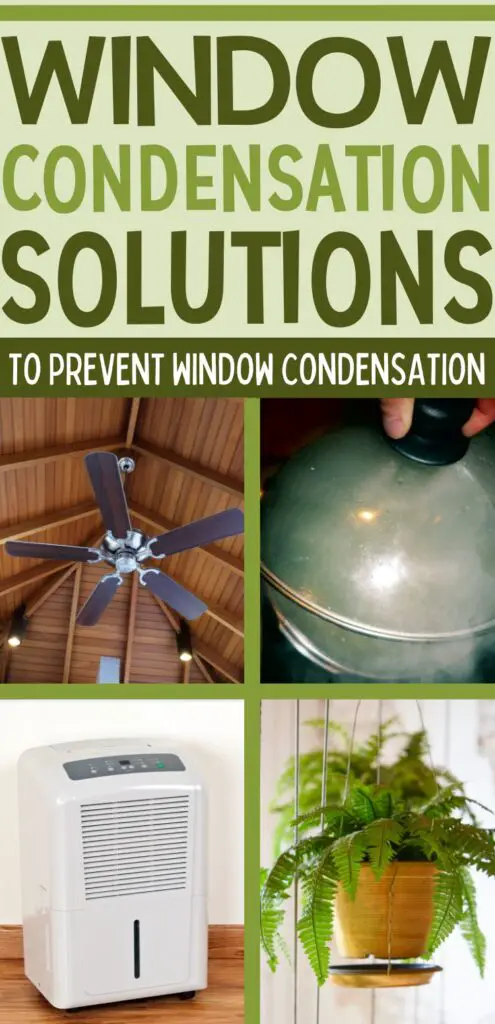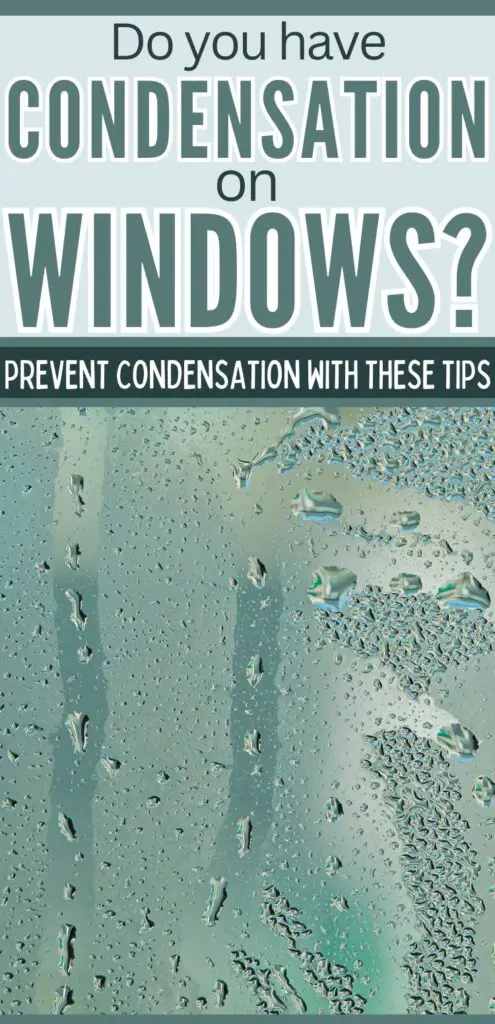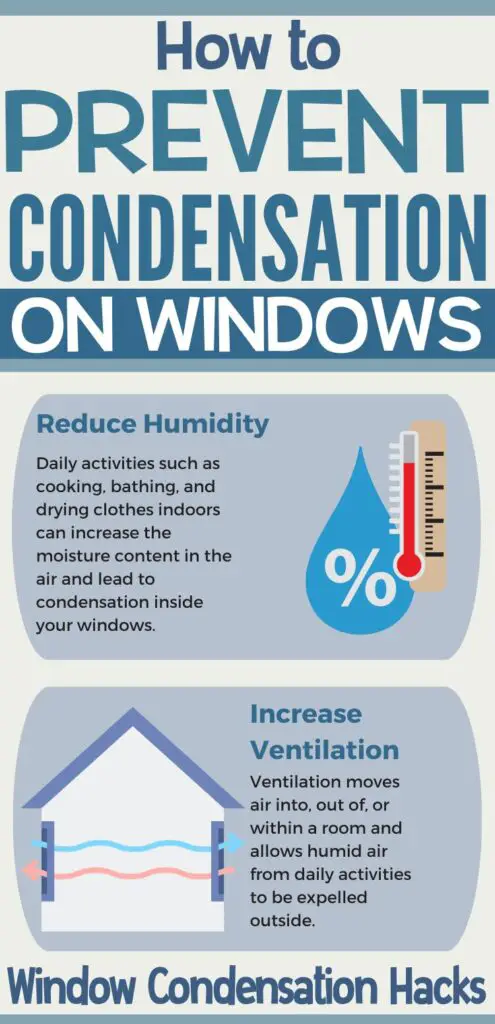Condensation on the inside of windows is a common issue that happens in many homes, especially during the colder months. When excess humidity in the warm air comes into contact with the colder surface of the window glass, it causes water droplets to form. It not only ruins the view, but these droplets can drip onto windowsills causing freezing and/or water damage, and may even cause mold growth if left unchecked.

Causes of Condensation on Windows
Condensation on the inside of windows occurs when warm, moist air collides with the colder surface of the window pane, even on new windows. Condensation often occurs when the following factors come into play:
High Humidity
Daily activities such as cooking, bathing, and drying clothes indoors can increase the moisture content in the air and lead to condensation inside your windows. Even sleeping can raise humidity and cause condensation from breathing out humid air in an airtight room.
Temperature Difference
During colder months, the difference between heated indoor temperatures and cold outside temperatures can create the perfect conditions for condensation to form. Even room to room temperature variations can cause condensation.
As an Amazon Associate I earn from qualifying purchases. This means if you click on a link and buy something I’ve recommended, I get a small commission at no additional cost to you. You can see my full Disclosure Policy here.
RELATED POST: How to keep pipes from freezing when it’s really, really cold out
Effects of Condensation
If left unaddressed, condensation can lead to a variety of issues. Two primary effects include:
- Damage to Surfaces: Prolonged exposure to moisture can cause water damage to window frames and sills, walls, and ceilings. It can also cause peeling paint, warping wood, and unpleasant musty smells.
- Mold and Mildew Growth: Molds can thrive on any organic matter, including windowsills, ceilings, walls and floors of homes with moisture management problems. Mildew often lives on walls, windowsills, and other places where moisture levels are high. In unaired places, such as basements, they can produce a strong musty odor.

How to Stop Condensation on the Inside of Windows
We live in an old farmhouse with sketchy insulation and old windows, so I’ve been dealing with this issue for a long time. The root causes of condensation can be prevented by managing the temperature differences and moisture levels in your home. I’ve found that keeping indoor humidity levels low and improving air circulation near windows can significantly reduce interior window condensation.
RELATED POST: Do you have a cold, drafty house? Easy fixes to draft-proof your home
How to Prevent Moisture on Your Windows
To effectively reduce condensation on the inside of my windows, I focus on two main strategies: reducing humidity and increasing ventilation. Ventilation allows humid air from daily activities to be expelled outside. This also helps in reducing the overall humidity indoors.
Lower the Humidity in Your Home
Every home is different, but a humidity level between 30% and 60% is typically ideal for keeping your home warm and comfortable in the winter, where you won’t see condensation on the windows. You can measure the humidity of your home using a hygrometer, which measures humidity and temperature and is easy to use as a thermometer.
If your humidity level is above 60%, here are some steps you can take to lower it:
Use a Dehumidifier
Dehumidifiers are designed to remove excess moisture from the air. Place them in areas with high humidity, such as basements, bathrooms, or other problem areas.
Adjust Indoor Plants
Plants are a natural way to reduce moisture in your home. However, while some plants like Boston Ferns and Spider Plants can absorb moisture, too many plants can contribute to humidity. Adjust the number of indoor plants if needed, and take care not to overwater them.
Limit Moisture
Try to limit items that introduce moisture into the air like humidifiers. Ensure that wet items like towels and clothes are thoroughly dried before storing. When my dryer broke, I was hanging the wet clothes on racks in the house. This caused major condensation on my windows!
Use Desiccants in Damp Areas
Desiccants are substances that reduce humidity by attracting and absorbing moisture from the surrounding air. Place desiccants like silica gel or calcium chloride in high-humidity areas such as closets to help absorb excess moisture. Alternatively, you can put a bowl of rock salt on your window sill and it will absorb moisture to lessen condensation.
Seal Ducts
Leaky air ducts can contribute to increased humidity. Check your home’s ductwork for leaks and seal any leaks to prevent the intrusion of humid air.
Cooking Practices
Use lids on pots and pans while cooking to minimize steam. Use your kitchen exhaust fan to expel cooking-related moisture.
RELATED POST: What to do When Your House is Too Hot in Summer

Increase Ventilation
Ventilation moves air into, out of, or within a room and allows humid air from daily activities to be expelled outside. Increasing the airflow within your home helps to promote the evaporation of any moisture. This also helps in reducing the overall humidity indoors.
Use Exhaust Fans
Exhaust fans are designed to remove the excess humidity that is created by showering, boiling water, and other activities that will create excess moisture in the air. They are also used to remove odors, fumes, and smoke from kitchens and bathrooms by drawing air out of the room and expelling it to the outside.
Use Fans
Keeping the air moving is an essential part of keeping excessive moisture away. Use ceiling fans or pedestal fans, or even turn your furnace fan from auto to on so that air is constantly circulating to evaporate moisture.
Keep Doors Open
Keeping your bedroom door open can reduce the amount of condensation inside windows. When you breathe, your breath contains humidity which is released into the room. If that humidity is trapped in the room, it can build moisture inside your room. Leave your bedroom door open to release the humidity to circulate throughout the house.
Open Windows
Opening windows is another way to circulate fresh air throughout your home and exhaust humidity. However, this may be difficult to do in the cold winter months. Keeping a window open for only 5 minutes can create enough airflow to lower humidity in a room.
Temperature Regulation
Maintaining a steady temperature inside your home is crucial to prevent condensation:
Insulate Windows
Add window insulation kits to create a barrier against the cold. These kits typically include a plastic film that you can apply directly to the inside of your windows. By creating an air-tight barrier around your windows, these kits trap a layer of air between the film and the glass, which acts as insulation between the conflicting temperatures. This effectively warms the window surface and reduces interior condensation.
Keep Interior Temperature Consistent
To minimize condensation in your home, keep the temperature inside your house consistent. If you are unable to keep it consistent, leave the doors of cooler rooms open to allow some heat into them. Ideally, the interior temperature of your home should be between 65 to 70 degrees Fahrenheit or 18 to 21 degrees Celsius.
RELATED POST: Chill Out for Less: Cheap Ways to Block Heat from Windows
What if I Have Condensation Between Window Panes?
Double-pane or double-glazed windows have two panes of glass with insulating gas between the panes. The additional layer of glass, plus the insulating gap in between is what makes these energy-efficient windows reduce heat loss through the window.
Unfortunately, condensation build-up is a sign that your windows airtight glazing seal has broken and the window will lose its insulating benefits. In this case, you cannot get rid of condensation. Unfortunately, the only solution is to replace the window panes. The good news is that it’s much more affordable to replace just the window panes instead of the whole window assembly.
Condensation on the outside of windows
During summer, exterior window condensation can appear early in the morning. This is caused by humid outdoor air warming up quickly and coming into contact with the cold windowpane outside of the window. This type of condensation is nothing to worry about, and it will clear on its own.
Long-Term Solutions
If you have tried the above suggestions and are still finding condensation on the inside of your windows, you might consider these long-term solutions that may involve some home renovations. Here are some ways to address the root causes of high indoor humidity and poor ventilation.
Improve Insulation
Enhancing your home’s insulation can prevent the warm, moist air that causes window condensation from reaching the cooler surface of your windows. Pay close attention to areas like your attic and walls. You may want to:
- Add higher-grade insulation material.
- Seal gaps around the windows and doors with weather stripping.
Upgrade Windows
If your windows are old, they might be the problem. Consider upgrading to double or triple-glazed quality windows which provide better thermal performance and reduce the likelihood of condensation.
- Double-glazed windows: Double-pane windows have two panes of glass with a gap in between, usually filled with an inert gas that minimizes heat transfer.
- Triple-glazed windows: Triple-pane windows consist of three glass panes and two gaps, providing even better insulation than double-glazing.
Fix Leaks and Seal Cracks
Repair any leaks in your home, as water intrusion can significantly contribute to indoor humidity. Seal cracks and gaps in attics, roofs, walls, windows, and doors to prevent outside moisture from entering. Also, check your humidity levels in your basement and crawlspace.
Update Ventilation Systems
Proper ventilation is key to reducing humidity levels in your home to help prevent condensation.
- Consider installing heat recovery ventilators (HRV) or energy recovery ventilators (ERV) as they exchange stale, humid air with fresh air from outside and balance moisture levels without losing heat.
By implementing these changes, you can greatly reduce the problem of moisture inside your house and improve the overall comfort of your living space.
RELATED POST: How to Get Sticky Sliding Doors Gliding Again
Frequently Asked Questions
Here are some practical tips and simple ways to stop condensation on your windows.
How can I prevent window condensation during the cold season?
I’ve found that increasing air circulation helps prevent window condensation in colder months. Running a dehumidifier or using fans or moisture absorbers can make a difference. Also, keeping the indoor temperature consistent can prevent humidity inside the house from hitting cold window surfaces and condensing.
Can you just wipe away condensation on windows to maintain a clear view?
Yes, using a squeegee or a dry cloth to wipe away moisture works well to maintain a clear view from your window. You can also place moisture-absorbing products like rock salt or silica gel near the windows to help keep the area dry.
Can household items like vinegar effectively reduce window condensation?
I have never found anything that can be applied to the inside of windows to reduce condensation. I have found that Rain-X applied to the outside window glass helps water run off and keeps the window clear. For prevention, focus on controlling humidity levels.
What steps can I take to avoid condensation buildup on my windows overnight?
To avoid overnight condensation buildup, make sure to ventilate the room before you go to sleep by opening a window slightly or using an exhaust fan. Also, it can be beneficial to keep plants away from windowsills, maintain a lower humidity level with a dehumidifier at night, or keep the door open while you sleep.
Why do my windows fog up inside and how can I address this issue?
Windows fog up inside due to the excess humidity in your home coming into contact with the cooler temperature of the glass surface. Kitchen and bathroom windows are more likely to fog up when cooking or showering without proper ventilation. Kitchen and bathroom exhaust fans help pull the moisture out of the room and opening the window should clear the fog up.
Can you use salt to prevent condensation?
Yes! Salt has hygroscopic properties, meaning it can absorb moisture from the air. When it’s really cold out, I place bowls of salt near the windows to help reduce the moisture level around them and lower the presence of condensation.


